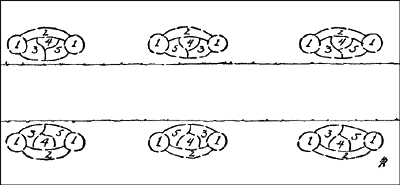Sequence and Rhythm
Sequence and rhythm are employed to create a feeling of logical follow-through, a leading up to the climax of the garden. They produce interest throughout the entire scheme. Nothing is so disheartening to the gardener as to have a visitor pass by his efforts with casual glance and polite but indifferent comment. This often happens because the garden lacks challenge or a demand for closer attention.
Sequence provides movement or flow and prevents the picture from being static. It is developed by repetition of the same element, a group or specimen, in a series of pairs balanced across the main axis. If the intervals between the groups are regular, rhythmic sequence is produced. Such a planting carries the eye along from the beginning to the end and leads from one picture to the next, tying the whole together into a more unified composition.
Rhythm alone is pleasing if the proportion of masses to intervals is well arranged. In long, narrow compositions a rhythmic arrangement is preferable to an episodic one that fails to develop continuity and seems illogical. When the color scheme is planned for a long border, a rhythmic sequence provides a frame on which to build a series of pictures. Suppose, for example, you planted recurrent masses of white phlox ten feet apart. They constitute the basic rhythm. Around each group arrange other things, say echinops, late hemerocallis, veronica, yellow centaurea in one case; pink and red phlox in another; and marigolds and bronze zinnias and ageratum in another. Rhythm remains but there is also variety to maintain interest.
Rhythm, as all musicians know, does not have to be regular. It can be syncopated as in modern dance music. Such syncopation is possible in planting, and may produce very interesting effects. Instead of regularly spaced and identical plant masses, try to vary the spacing considerably without destroying either balance or rhythm. In fact, in all but the most formal compositions, some syncopation is useful to soften the effect and prevent monotony. The more informal the scheme, the more syncopation is desirable, until natural rhythms are approached. Man-made rhythms should have definite space relationships. That is what distinguishes them from nature’s. Man points up, develops the natural scene, and makes it art!
Planting for sequence and rhythm also helps to restrict unwieldy lists. To achieve the necessary effects you must use a number of the same plants repeatedly. If this cuts down too much on the varieties you think you want, don’t throw away the design. Put the extra favorites in cutting rows, and keep your garden artistically right. (Plate 12.)
Sometimes people justify haphazard planting by calling it old-fashioned. They admire quaintness. This is side-stepping the issue. Old-fashioned gardens, if they were good, were no more casual than those of today. Too often we reverence and imitate the old just for the sake of its age. We are not sufficiently critical of its merit. Not everything ancient is meritorious or worth copying. Each age must do its own thinking if it is to progress, and that applies to gardens too.

Plate 12. Planting for Sequence and Rhythm.
2. Phlox Leo Schlageter
3. Veronica maritima subsessilis
5. Linum perenne
- Segregation – Segregation, in gardening, serves the same purpose as a frame for a painting, or a pedestal for a statue. It sets apart and at the same time holds together the composition within.
- Unity – In the garden pattern all parts of the design, path, bed, or border, must be interrelated. The whole must hang together. Anything extraneous detracts from the quiet satisfaction of a unified scheme.
- Balance – In American gardens we tend to rely on formal balance because most of our garden sites are level, or nearly so, and boundaries are made up of straight lines and right angles.
- Accent – Always remember that an accent is in reality an exclamation point, and use it that way. Place accents so as to create interest through contrast in form, foliage, or color.
- Sequence and Rhythm – These principles are employed to create a feeling of logical follow-through, a leading up to the climax of the garden. They produce interest throughout the entire scheme.
- The Garden Climax – Towards this point everything else leads, the garden paths, the beds, and the planting in them. Here are placed the most effective groups, the best plants, the richest compositions. All clearly say, This is it!
- Principles of Plant Arrangement – The two kinds of design, plant arrangement in the garden and flower arrangement in a container, are closely related, yet skilled arrangers often fail to develop the possibilities for charm and beauty in their gardens. Actually it is only the application which differs.
- Next Page: Unity
- Return from Segregation to: Landscape-Guide Home
Please tell us what you think about this page. (E-mail addresses are kept in complete confidence).
